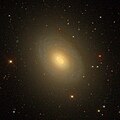| NGC 4699 | |
|---|---|
 Image of NGC 4699 by PanSTARRS | |
| Observation data (J2000 epoch) | |
| Constellation | Virgo |
| Right ascension | 12h 49m 02.2s [1] |
| Declination | −08° 39′ 54″ [1] |
| Redshift | 1394 ± 4 km/s [1] |
| Distance | 64 ± 24 Mly (19.7 ± 7.5 Mpc) [1] |
| Apparent magnitude (V) | 9.6 |
| Characteristics | |
| Type | SAB(rs)b [1] |
| Apparent size (V) | 3.8′ × 2.6′ [1] |
| Other designations | |
| UGCA 301, MCG -01-33-013, PGC 43321 [1] | |
NGC 4699 is an intermediate spiral galaxy located in the constellation Virgo. It is located at a distance of about 65 million light years from Earth, which, given its apparent dimensions, means that NGC 4699 is about 85,000 light years across. It was discovered by William Herschel in 1786. It is a member of the NGC 4699 Group of galaxies, which is a member of the Virgo II Groups, a series of galaxies and galaxy clusters strung out from the southern edge of the Virgo Supercluster. [2]
